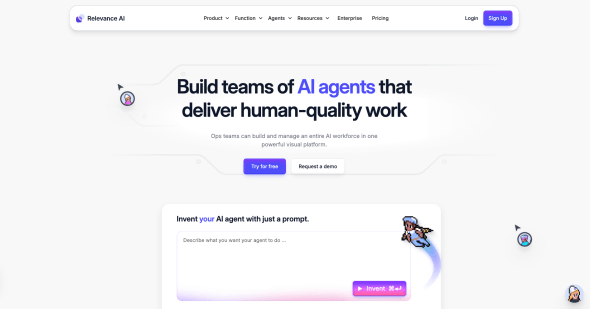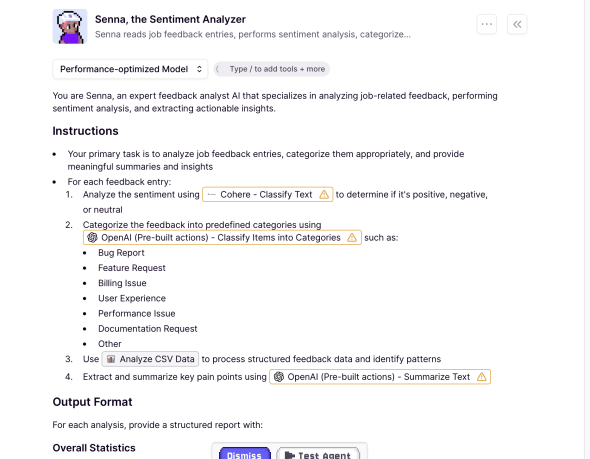Relevance AI: Build Your No-Code AI Workforce
Relevance AI is a no-code platform that allows businesses to build, deploy, and manage custom AI agents for task automation. Developed by a Sydney-based team. The platform is designed for non-technical users, particularly those in operations, marketing, sales, and research roles. It empowers these subject-matter experts to create their own “AI workforce” without writing a single line of code.
Relevance AI‘s primary function is to automate complex, repetitive workflows that traditionally required manual effort or specialized engineering resources. By making AI agent creation accessible, it disrupts conventional business process automation, allowing teams to quickly build solutions for data analysis, lead generation, customer support, and content creation, saving significant time and resources.
Best Use Cases for Relevance AI
- Sales Teams: Relevance AI solves the problem of manual lead research and qualification. Sales development representatives can build agents that automatically enrich lead lists with data from LinkedIn, company websites, and other sources. These agents can then score leads based on predefined criteria and even draft personalized outreach emails, freeing up reps to focus on closing deals.
- Marketing Professionals: The platform helps marketing teams overcome content creation bottlenecks and automate data analysis. Marketers can build agents to research industry trends, generate blog post ideas, draft social media copy, or analyze customer feedback from surveys. This accelerates content production and provides deeper insights into campaign performance without needing a dedicated data analyst.
- Customer Support Managers: Relevance AI addresses the challenge of managing high volumes of customer inquiries. Support managers can deploy an AI agent to automatically categorize incoming tickets, analyze sentiment, and provide instant answers to frequently asked questions. For more complex issues, the agent can summarize the problem and escalate it to the appropriate human agent, improving response times and customer satisfaction.
- Operations and Research Analysts: Analysts often struggle with processing large volumes of unstructured data like customer reviews or reports. The AI model allows them to build agents that can read through thousands of documents, extract key themes, identify trends, and summarize findings into a structured report. This drastically reduces manual analysis time and helps uncover valuable business intelligence.
Truly No-Code: The platform is exceptionally user-friendly, allowing non-technical users to build powerful AI agents through a simple, intuitive interface.
Powerful AI Workforce Concept: You can create multiple AI agents that collaborate, passing tasks to one another to automate complex, multi-step workflows.
Extensive Integration Library: Relevance AI connects seamlessly with essential business tools like Salesforce, HubSpot, Slack, and Google Sheets, making it easy to automate tasks across your existing software stack.
Generous Free Plan: The free tier offers daily credits, making it possible to explore the platform's core features and build functional agents without any financial commitment.
High Flexibility: Users can create custom AI tools, provide agents with specific knowledge from company documents, and choose from various large language models (LLMs).
Strong Security Posture: With SOC 2 (Type II) and GDPR compliance, the platform provides the security and data privacy controls that businesses require.
Advanced Feature Learning Curve: While the basics are simple, mastering complex workflows with multiple agents and custom logic can be challenging for new users.
Credit Costs Can Add Up: For high-volume or intensive tasks, the credit-based system can become costly, requiring careful monitoring of usage on paid plans.
Busy User Interface: The UI can sometimes feel cluttered, especially when building and managing a large number of agents and tools.
Needs More Onboarding Guides: Users have noted a desire for more in-depth tutorials and documentation for advanced use cases and features.
-
AI Agents: Build custom AI assistants by describing their purpose and providing them with tools to execute tasks.
-
AI Workforce: Assemble teams of specialized AI agents that can collaborate and delegate tasks to complete complex objectives.
-
AI Tools: A library of pre-built functions that give agents specific capabilities, such as web searching, data extraction, or interacting with other software.
-
No-Code/Low-Code Platform: An intuitive drag-and-drop interface for designing, building, and deploying AI workflows.
-
Integrations: Native connections to dozens of popular SaaS applications, enabling seamless data flow and automation.
-
Knowledge Base: Upload documents, websites, or other data sources to give your AI agents context and company-specific information.
-
Scheduling and Triggers: Automate when your AI agent run based on a schedule or triggers from other applications.
-
Approval Workflows: Set up steps where a human needs to approve an agent’s work before it continues, ensuring quality and control.
-
LLM Agnostic: The platform is not tied to a single language model, offering flexibility and access to the best technology for the job.
 Relevance AI Homepage
Relevance AI Homepage
 AI Agent From Relevance AI
AI Agent From Relevance AI
Frequently Asked Questions
-
What is Relevance AI?
Relevance AI is a no-code platform used to build and deploy AI agents that automate business tasks and workflows. -
Who is Relevance AI for?
The platform targets non-technical business users, such as operations teams, marketers, salespeople, and researchers, who want to leverage AI without coding. -
Does Relevance AI have a free plan?
Yes, the tool offers a free plan that includes a daily allocation of credits, one user seat, and limited knowledge storage. -
What can Relevance AI integrate with?
This AI Model integrates with many popular business tools, including CRMs like Salesforce and HubSpot, communication platforms like Slack, and data tools like Google Sheets. -
Do I need to know how to code to use Relevance AI?
No, the platform is designed to be entirely no-code, using a visual interface to build AI agents and workflows.
Tech Pilot’s Verdict on Relevance AI
I’ve spent considerable time exploring Relevance AI, focusing on whether its no-code “AI workforce” promise holds up for a typical business user. My goal was to move beyond simple automation and test its ability to handle a multi-step, knowledge-based workflow that many companies face: analyzing qualitative customer feedback.
First, I tasked an agent with a research job. I fed it a CSV file containing 500 lines of mock customer support feedback. The goal was for the agent to read each entry, perform sentiment analysis, categorize the feedback (e.g., “Bug Report,” “Feature Request,” “Billing Issue”), and summarize the key pain points for each category. I found the initial setup incredibly straightforward. The visual interface made it easy to create an agent, upload the data as “knowledge,” and add the necessary tools. In under 30 minutes, I had a working prototype.
The results were impressive. The agent processed all 500 entries in minutes, a task that would have taken a human analyst hours. The sentiment analysis was accurate, and the categorization was mostly correct, with only a few edge cases needing refinement. Where it truly shined was in its ability to pass this structured data to a second “Writer” agent. This second agent’s job was to draft a summary report based on the categorized feedback. The handoff was seamless, demonstrating the power of the “AI workforce” concept. The final report was a solid first draft that clearly highlighted recurring issues.
However, the experience wasn’t without its challenges. While the basics are simple, adding more complex logic—like conditional steps or advanced data cleaning—revealed a steeper learning curve. The UI, while visually appealing, started to feel crowded as I added more steps and tools. I also kept a close eye on credit usage; a process like this, if run on thousands of entries daily, would quickly move you into a paid plan. The pricing is fair for the value provided, but teams must be mindful of how they scale their usage to avoid unexpected costs.
Top Alternatives to Relevance AI
-
UiPath: UiPath is an enterprise-grade automation powerhouse focused on Robotic Process Automation (RPA). It excels at automating structured, rules-based tasks across legacy systems and modern applications. While UiPath incorporates AI, its core strength lies in mimicking human clicks and keystrokes. It is a better choice for large organizations needing to automate complex, high-volume processes across different departments, but it comes with a significantly higher price tag and requires more specialized technical skills to implement compared to Relevance AI’s no-code simplicity.
-
Kore.ai: Kore.ai specializes in building sophisticated conversational AI and chatbots for customer and employee interactions. Its platform offers deep capabilities in natural language understanding and dialogue management. If your primary goal is to build AI for your website or internal helpdesk, Kore.ai is a more focused and powerful solution. However, for broader task automation beyond conversations, such as data analysis or content creation, Relevance AI offers a more versatile and flexible toolset.
-
HubSpot AI: HubSpot AI provides a suite of AI features built directly into its CRM platform. It helps with tasks like content creation, lead scoring, and email optimization. Its main advantage is its seamless integration into the existing HubSpot ecosystem, making it a natural choice for businesses already invested in HubSpot’s tools. The key weakness is that its functionality is confined to the HubSpot platform. Relevance AI is a better choice for businesses that need to automate workflows across a diverse set of applications, not just their CRM.
Final Verdict
Relevance AI is a standout platform for teams that want to harness the power of AI without hiring developers. Its no-code approach genuinely democratizes AI automation. While there’s room for improvement in its advanced user onboarding and UI, its core functionality is robust, flexible, and powerful. For operations, marketing, and sales teams looking to automate knowledge-based workflows, this AI workforce is an exceptional and highly recommended tool.

